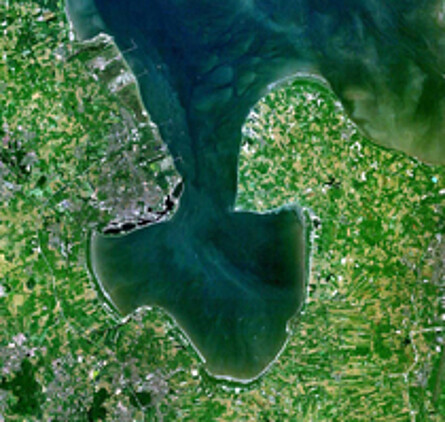
(Illustration: I. Eichfeld, NIhK)
Development of the Jade Bight since the End of the last Ice Age – a Baseline Study recording scientific and cultural Background Data for a Lower Saxony Coastal Database
Lowland coastal zones like the Jade Bight area are extraordinarily dynamic natural habitats, presenting humans with ever changing challenges, but alongside immense dangers they also provide numerous possibilities. Over the course of time the inhabitants of the North Sea coast have developed different strategies to cope with environmental dangers and make use of the opportunities afforded by this landscape. The data on settlement- and cultural landscape history collected in the Jade Bight Project are intended to provide a diachronic view of man’s handling of the potentials and risks of the coastal areas.
A comprehensive scientific and cultural synopsis of the Jade Bight and its environs from the end of the last Ice Age to the modern period has been created within the framework of this interdisciplinary project, funded through the “Niedersachsen Vorab”-scheme of the Volkswagen Foundation. A web-based GIS database has been created, containing scientific and cultural information on the development of the Jade Bight, collating and linking data on geosphere, biosphere and anthroposphere.
Between 2008 and 2011, the Lower Saxony Institute for Historical Coastal Research (NIhK) cooperated on the realisation of these objectives with the ICBM Terramare, the Department for Oceanography of the Senckenberg Institute in Wilhelmshaven; and the Coastal Research Facility of the Lower Saxony Agency for Water Management, Coastal- and Environmental Protection on the island of Norderney (NLWKN-FSK).
Two NIhK departments were working on question addressed by the Jade Bight Project: Ingo Eichfeld and Johannes Ey of the Department for Cultural Sciences were working on issues concerning settlement- and cultural landscape history of the Jade Bight area.
The connection between archaeology and geology was achieved in the Salztorf (saline peat) project, examining the significance which the extensive peat cutting for salt extraction has had for the development of the Jade Bight. The sub-project on saline peat was carried out by Annette Siegmüller and Friederike Bungenstock.
Bibliography
Siegmüller, A., u. Bungenstock, F., 2010: Salztorfabbau im Jadebusengebiet - Prospektion von anthropogenen Landabsenkungen und ihren Folgen. Nachrichten für Niedersachsens Urgeschichte 79, 201-220.
Eichfeld, I., Bartholomä, A., Beck, M., Bungenstock, F., Freund, H., Karle, M., Kröncke, I., Schückel, U., Siegmüller, A., Silinski, A., Stratmann, V., Wartenberg, W. & Wehrmann, A., 2010: The Jade Bay Project. A summary of targets and planned activities. In: Marencic, H., Eskildsen, K., Farke, H. and Hedtkamp, S. (Hrsg.), Proceedings of the 12th International Scientific Wadden Sea Symposium "Science for Nature Conservation and Management", Wilhelmshaven, 30 March – 3 April 2009. Wadden Sea Ecosystem No. 26. Common Wadden Sea Secretariat, Wilhelmshaven, Germany.
Eichfeld, I., 2010: Landscape and Settlement History of the Western Heete Estuary, Butjadingen (district of Wesermarsh, Lower Saxony). In: Marencic, H., Eskildsen, K., Farke, H. and Hedtkamp, S. (Hrsg.), Proceedings of the 12th International Scientific Wadden Sea Symposium "Science for Nature Conservation and Management", Wilhelmshaven, 30 March – 3 April 2009. Wadden Sea Ecosystem No. 26. Common Wadden Sea Secretariat, Wilhelmshaven, Germany.
Eichfeld, I., 2010: Diluted causalities: The variability of human response to environmental change. Examples from the North Sea Coast, Lower Saxony, Germany. In: Kiel Graduate School "Human Development in Landscapes" (Hrsg.), Landscapes and Human Development: The Contribution of European Archaeology. Universitätsforschungen zur Prähistorischen Archäologie 191, 273-284. Bonn.
Ey, J., 2010: Initiation of dike-construction in the German clay district. In: Marencic, H., Eskildsen, K., Farke, H. and Hedtkamp, S. (Hrsg.), Proceedings of the 12th International Scientific Wadden Sea Symposium "Science for Nature Conservation and Management", Wilhelmshaven, 30 March – 3 April 2009. Wadden Sea Ecosystem No. 26. Common Wadden Sea Secretariat, Wilhelmshaven, Germany.

